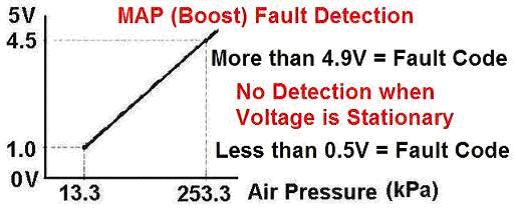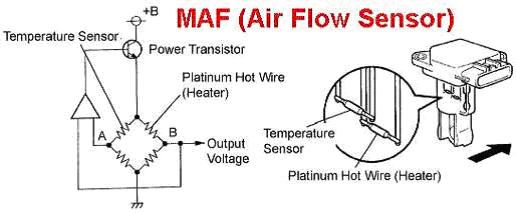Tech info on MP - MAP & MAF Sensors
Find your vehicle...
Tuning Technical Information
We are increasingly getting inquiries from customers having problems with standard vehicles. They are being frustrated with New Car Dealers who are not listening to their complaints about their vehicles poor Economy or Performance. Dealers are finding themselves caught in the middle as manufacturers dumb down the test procedures which the dealers are only allowed to carry out. They are only permitted to replace what their Diagnostic Equipment determines, so faulty sensors sending incorrectly calibrated signals, result in the Diagnostic Equipment not seeing the real faults. These Pages are here to give you a better understanding of how your vehicle works & help you diagnose problems you are having with your vehicle.
MAP (Boost) Sensor

The MAP (Manifold Absolute Pressure or Boost Sensor) converts the Boost pressure in the inlet manifold into a voltage signal of between 0-5v. A few manufacturers are having problems with MAP sensor accuracy and failures. Many mechanics still do not understand the significance of this problem. The first paragraph in the MAP Sensor section of manufacturers work shop manual states:
“The ECU determines the basic injection duration and injection advance timing based on the voltage output by the MAP Sensor. The MAP Sensor monitors the absolute pressure inside the intake manifold. As a result the ECU controls the air-fuel ratio at the proper level under any driving conditions, and fuel control accuracy is not influenced by fluctuations in the atmospheric pressure due to factors such as high altitude, etc.”
The MAP sensor will have 3 or 4 wires, earth, power (5v), signal (0-5v) and Temp signal (on 4 wire sensors). We suggest testing voltage on the sensor signal wire, which on most Toyota, Nissan & Mitsubishi is the middle wire. We suggest measuring the MAP sensor signal voltage at Ign On, at idle rpm, 2000rpm and 3000rpm. On some Nissan’s the sensor is located in front of radiator, on driver’s side, accessed by removing the grill or using an extended probe on a multi-meter. For example, Early Nissan MAP sensor should read 1.9v at Idle and 2.25v at 2000rpm with no load. First problem car tested had 1.94v at idle and 1.97v at 2000rpm. On some cars the voltage remains fixed at one level.
If voltage is out of range the first thing to do is remove and clean sensor of all oil residues, and then re-test voltages. On some vehicles like Mitsubishi, the pipe becomes blocked. If readings are still out of range replace sensor. Once new sensor is fitted, test again, out of 5 new sensors we received from Nissan, one was faulty. So this also shows that some sensors have been faulty from new.
The Scan tool can show high boost at low rpm if the idle voltage is higher than normal. Vehicle can have rough idle due to rich mixture. If the ECU reads higher volts, the pulse widths at injectors will be longer (increasing fuel to match boost), so an Injector Control Tuning box will think this is pedal input. Changes to the program in the Tuning box will help but will not fix the problem. At higher rpm voltage is lower than required, boost ends up much higher than scan tool shows due to ECU trying to fix low boost reading via VNT. But fuel is reduced due to low boost voltage reading, so car has no power at higher rpm. A quicker way to diagnose a faulty MAP Sensor is to have a Boost Gauge fitted, and then you can see if your boost is becoming higher than normal. At this stage the vehicles ECU can not see that the Boost is actually too high. A Scan Tool can not diagnose a faulty MAP Sensor but can be used at the same time as well as a external Boost Gauge. An example of this was a Toyota V8 being driven showing 5psi on Scan Tool while at same time showing 24psi on Boost Gauge, no fault codes were being displayed but MAP Sensor was not sending ECU correct Boost information.
Buy a Morepower Tuning Box for my vehicle.
MAF (Mass Air Flow)

The Mass Air Flow (MAF) meter measures the amount of air flowing through the Intake System. The ECU uses this information to determine the fuel injection time and provide a proper air-fuel ratio; with further correction via the MAP Sensor - which is not influenced by fluctuations in the atmospheric pressure. MAF Sensors frequently fail, despite being located after the air filter; they still get damaged by dust, water or oil. They can be cleaned by spraying the inside sensor with Circuit Board cleaner. Their calibration can be checked by measuring their output signal voltage the same as we do for the MAP Sensors. Symptoms of dirty MAF are rough idle speed as vehicle defaults to higher Fuel Rail Pressure. Surging can occur if vehicle has Pedal Box which further increases Fuel Rail Pressure at light & part throttle driving.
Buy a Morepower Tuning Box for my vehicle.
Find out more about:

